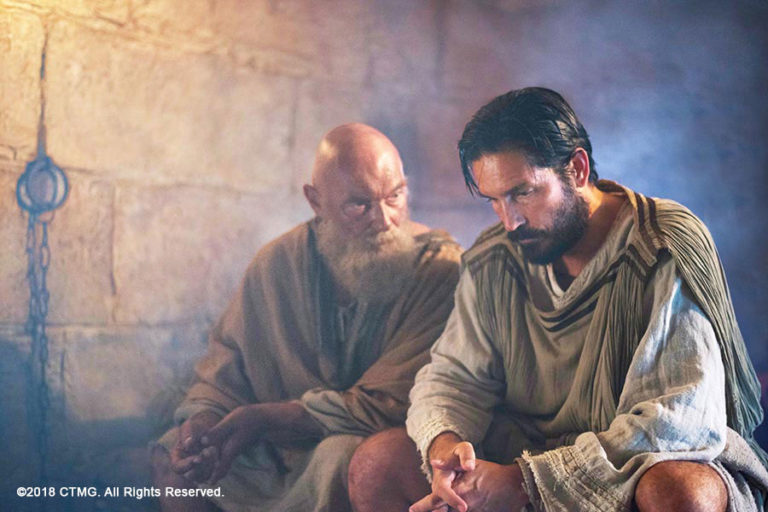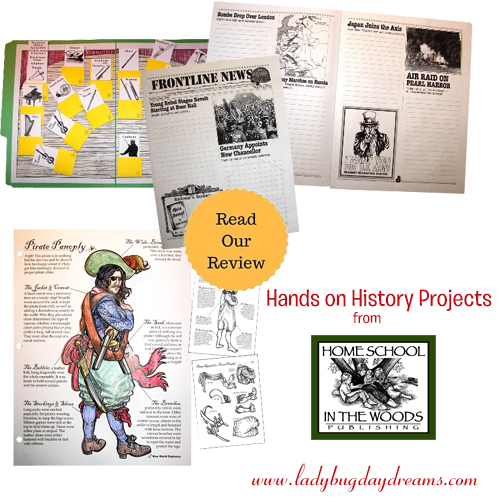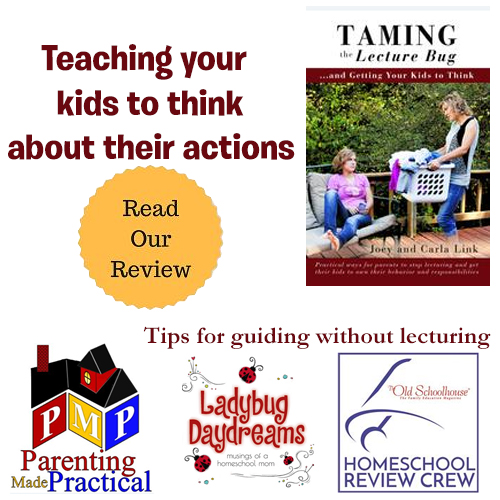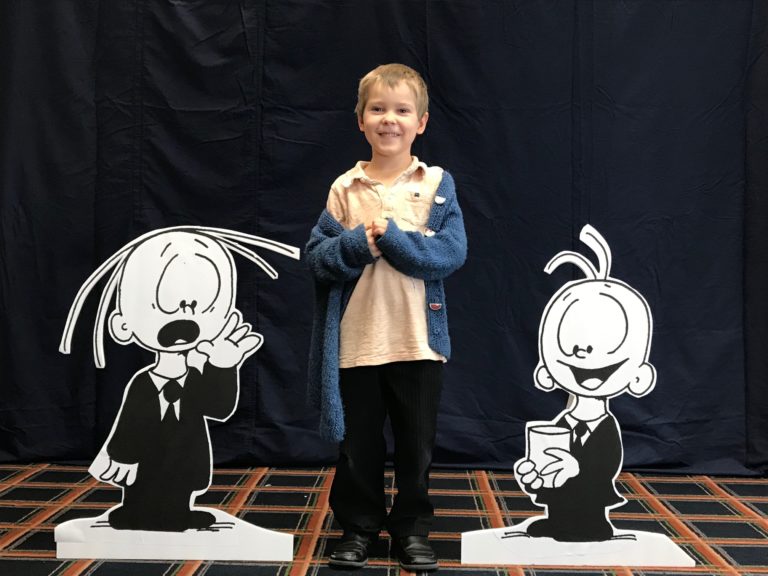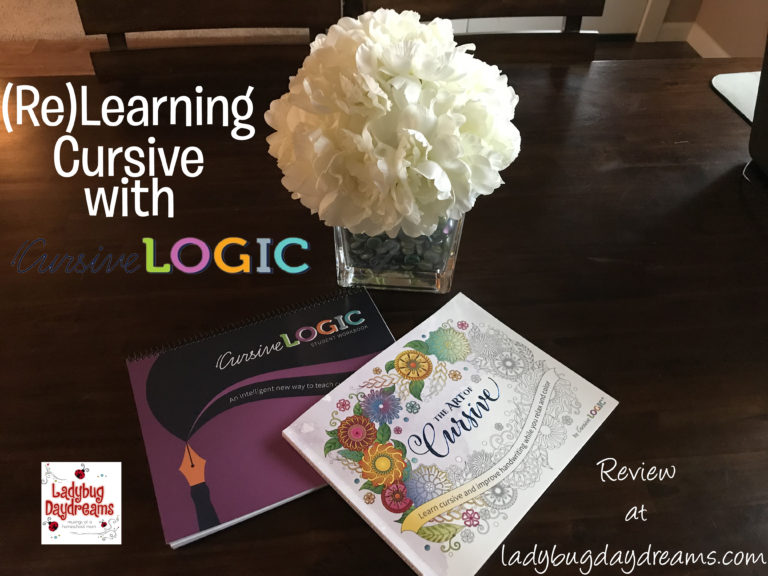Month: March 2018
Lots and Lots of Children’s Books (review)
The little boys (ages 5 and 2) and I have had the pleasure the past few weeks of reading a few books by Carole P. Roman. We were able to choose three books from the Carole P. Roman books and collections. I opted for one chapter book, one fun picture book, and one learning picture book for us. All of the choices have been huge hits with my children, and I’ll take a few minutes here to discuss each one.
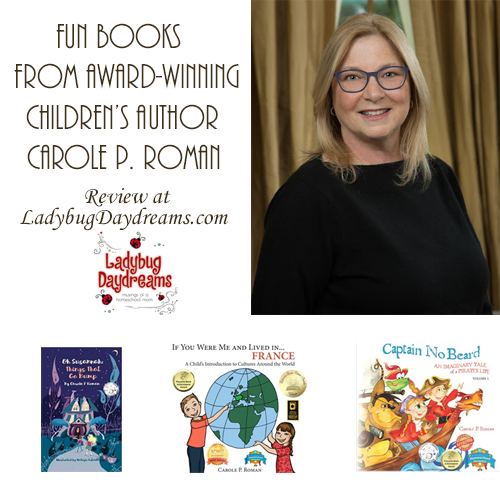
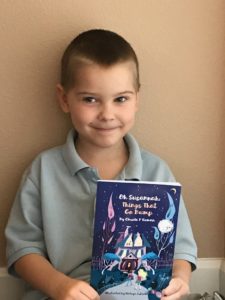 For our chapter book, I picked Oh Susannah: Things That Go Bump ($6.99 paperback, $0.99 Kindle). This book is about 40 pages, divided over 10 chapters. It tells the story of a little girl named Susannah who is going to be having a sleepover at her friend Lola’s house. The only problem is that Lola lives in a haunted house! Not really, but it is a big, old, creaky house, and Susannah is afraid to go there. Over the course of the novel, Susannah comes into contact with characters (her parents and other friends) who help her see the world – especially the scary parts – in new ways. Susannah is very skeptical, and the first bit of her time (2 or 3 chapters) at Lola’s is just as frightening and nerve wracking as she expects. But by the end of the book, she learns that some things aren’t always as they seem.
For our chapter book, I picked Oh Susannah: Things That Go Bump ($6.99 paperback, $0.99 Kindle). This book is about 40 pages, divided over 10 chapters. It tells the story of a little girl named Susannah who is going to be having a sleepover at her friend Lola’s house. The only problem is that Lola lives in a haunted house! Not really, but it is a big, old, creaky house, and Susannah is afraid to go there. Over the course of the novel, Susannah comes into contact with characters (her parents and other friends) who help her see the world – especially the scary parts – in new ways. Susannah is very skeptical, and the first bit of her time (2 or 3 chapters) at Lola’s is just as frightening and nerve wracking as she expects. But by the end of the book, she learns that some things aren’t always as they seem.
I’m glad I had a chance to read this book (we read 1-2 chapters a day, depending on length) with Small Fry. Even though a few sections were rather creepy and scary for him, I feel like it helped him learn that it’s better to talk over your feelings and push through things that you’re afraid of (within reason).
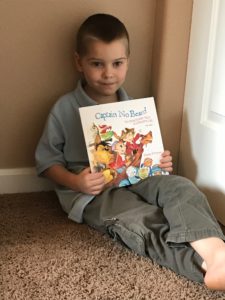 The fun picture book we chose was Captain No Beard: An Imaginary Tale of a Pirate’s Life (volume 1) (currently on sale for $5 paperback, $1.99 Kindle). Because Captain No Beard is a typical picture book, we read it in one sitting – and have since read it dozens more times!
The fun picture book we chose was Captain No Beard: An Imaginary Tale of a Pirate’s Life (volume 1) (currently on sale for $5 paperback, $1.99 Kindle). Because Captain No Beard is a typical picture book, we read it in one sitting – and have since read it dozens more times!
Captain No Beard is the story of a boy, his cousin, and a crew of animals out on the open sea. Together, they learn some pirate words, spot land, rescue one of the members from falling overboard, and have a conversation with a mermaid. There’s a fun reveal at the end that completely caught my boys by surprise (though a grownup should be able to guess is based on the title of the book). They had so much fun with this book; I don’t think they stopped laughing once through the whole thing. I loved reading them a book that they so clearly loved hearing. They will love to get another volume of this series one day soon. And yes, Dragonfly did listen with us even though he’s not in the pictures. He’s not feeling very well this week and was being a bit stubborn at photo time.
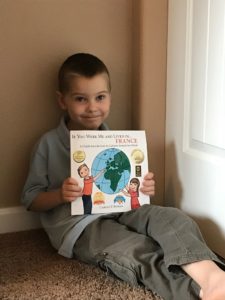 The final book we received was If You Were Me and Lived In… France ($9.99 paperback, $1.99 Kindle). Because we’ve been studying French as our foreign language for several years (less than we should recently, since my laptop went kaput several months ago), I’ve wanted to get this book for the kids for a while, but it hadn’t happened yet. I’d intended for the big kids to read it on their own, and while they did we also had a side benefit that I hadn’t anticipated with this title: the little kids love it too! Just this morning, Dragonfly (2) brought it to me and asked to “read.” Of course I obliged! From nearly the first page, he was even repeating some of the French words after me.
The final book we received was If You Were Me and Lived In… France ($9.99 paperback, $1.99 Kindle). Because we’ve been studying French as our foreign language for several years (less than we should recently, since my laptop went kaput several months ago), I’ve wanted to get this book for the kids for a while, but it hadn’t happened yet. I’d intended for the big kids to read it on their own, and while they did we also had a side benefit that I hadn’t anticipated with this title: the little kids love it too! Just this morning, Dragonfly (2) brought it to me and asked to “read.” Of course I obliged! From nearly the first page, he was even repeating some of the French words after me.
This book, which is part of a series that teaches children about different cultures all over the world, does a good job explaining what things are like for French children. (At least I think it does. I’ve never actually been to France to be able to compare.) It tells about the capital city of Paris and the Eiffel Tower. It takes you on a trip to a boulangerie (bakery). It describes he names that are popular in France, for both boys and girls. It just generally gives a lot of good, but fun, information about the subject. My only critique of this one is that the pronunciation guide isn’t always super precise. Some of the words are given the American pronunciation rather than the French pronunciation, but others are given the French pronunciation. For example, boulangerie is given its French pronunciation (boo-LAHN-jair-ee), but Eiffel is given the English/American pronunciation (EYE-full). The French pronunciation of Eiffel is ee-FELL. Generally speaking, that’s fairly minor (because I know enough French to have said the words correctly to the little boys).
We have had such a good time with all three of these books by Carole P. Roman. Her books are super fun, even those that are more educational than “just for fun.” I am so glad we were blessed to receive these books for review.
Members of the Homeschool Review Crew are reviewing a large selection of books from the Carole P. Roman books and collections this week. Make sure to click the banner below to find out more! And if you’re the social media type, you can find Carole on the following platforms:
Blessings,

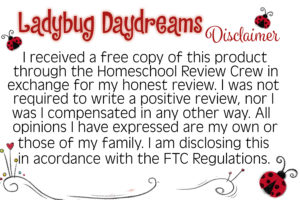
Just in Time for Easter: Paul, Apostle of Christ
Paul’s writings were vital to the spread of early Christianity, and it was Luke who helped him get the word out. In a new film from director Andrew Hyatt comes Paul, Apostle of Christ, the story of how Paul (in prison) and Luke work tirelessly to get the message out.
Disclaimer: I haven’t seen this movie yet as it doesn’t open until tomorrow. The information I’m sharing is from the website as well as the promotional material I was provided.
The filmmakers took great pains to keep this film as biblically accurate as possible, using only scripture as their source material. After having seen a few Bible story movies in the past few year that were definitely not biblical (*ahem* Noah *ahem*), I’m really impressed with this statement.
This historically accurate film brings to life two very different men, bonded together by their love for Jesus. They realize separately that the city of Rome is being overtaken by evil, so they struggle to finish their respective books, leaving their writings for generations of people after them.
There are two main themes in the film that are very relevant in today’s culture. Number 1, evil is all around us. It can manifest very suddenly and without cause. We see that weekly (or more often…) in the news, especially things like school shootings. Number 2, and the main lesson to learn from Paul and Luke: God’s love is the only answer.
I’m also excited that Paul is getting a nationwide release; often, these types of films don’t come to my area. (We don’t have a small population here in the Portland area, but we’re not as big as NY or LA, so we often get skipped.) To see if the film will be in a theater near you, the movie website has a spot for you to enter your zip code and it will pull up locations and showtimes (it opens tomorrow, March 23, 2018). If it is near you, you can buy your tickets from there too.
Blessings,
Disclosure (in accordance with the FTC’s 16 CFR, Part 255: “Guides Concerning the Use of Endorsements and Testimonials in Advertising”): Many thanks to Propeller Consulting, LLC, Collide Media Group and Columbia TriStar Marketing Group, Inc. for providing tickets to see the movie on its release in exchange for this promotional post. Opinions are 100% my own and NOT influenced by monetary compensation.
Knitted Sweater for Seahawk
My little kids get all sorts of sweaters knit for them (by me). Because they’re so small, they go really quickly and are a good way to try out new patterns – small commitment of both yarn and time. The older two get sweaters very occasionally. In fact, they’ve each only gotten one from me versus the 3-4 that each of the little kids has. Being nearly adult sized (Munchkin) and actually adult sized (Seahawk), both the money and time needed are quite a bit bigger.
A while ago, I decided that it was time for me to make a sweater for Seahawk. He was the only kid who hadn’t gotten one yet, and I was feeling a little bad about that. So he and I sat down at the computer together and surfed Ravelry for patterns. I guided him toward patterns from Tin Can Knits because I knew that any pattern I bought from them would be a good value (because all their patterns come in a huge variety of sizes from “baby to big”). Before too long, he picked the Jones cardigan. It was an ambitious project because it’s made from a stitch pattern called “moss stitch,” rather than the traditional stockinette. Add to that the large number of braided cables and I knew I was in for a long project. But I tackled it for him.
 The pattern was a lot more complex than I expected. Don’t mistake complex for difficult, though. It wasn’t hard; it was just complicated. And for reasons I can’t place my finger on, I didn’t really like making it. I don’t know if it was the pattern itself or if I just chose an unpleasant yarn (it’s 50% lamb’s wool, 50% cotton). But whatever it was, I would almost always choose a different project to work on instead. Finally, I made the decision that I had to a certain amount of work on this sweater before I’d allow myself to work on any other projects. Then, about a month ago, I told myself no other projects at all until this one was done. You’d think that would have motivated me to just power through it, but no. I still took days off from knitting altogether sometimes just to avoid this project. But finally, about a week ago, I bound it off. What a happy day that was! Not only do I not have to work on it anymore, but it was such a big project that it just felt good to have finished it.
The pattern was a lot more complex than I expected. Don’t mistake complex for difficult, though. It wasn’t hard; it was just complicated. And for reasons I can’t place my finger on, I didn’t really like making it. I don’t know if it was the pattern itself or if I just chose an unpleasant yarn (it’s 50% lamb’s wool, 50% cotton). But whatever it was, I would almost always choose a different project to work on instead. Finally, I made the decision that I had to a certain amount of work on this sweater before I’d allow myself to work on any other projects. Then, about a month ago, I told myself no other projects at all until this one was done. You’d think that would have motivated me to just power through it, but no. I still took days off from knitting altogether sometimes just to avoid this project. But finally, about a week ago, I bound it off. What a happy day that was! Not only do I not have to work on it anymore, but it was such a big project that it just felt good to have finished it.
The sweater took me almost exactly a year to finish – by far my longest knitting project ever. Fortunately Seahawk doesn’t seem to have gone through too much of a growth spurt during that time, so it still fits him. And he gets lots of compliments when he wears it out (which has been basically every single time he’s left the house since I finished).
As glad as I am that the sweater is done, I’m even more glad that he likes and appreciates the work that went into it. Knowing that he loves it makes all the “blood, sweat, and tears” totally worthwhile.
Blessings,
Hands On History (Home School in the Woods review)
History is an easy subject to make dry and boring. It’s just as easy to make it fun and interesting. So why wouldn’t you go for the latter? That’s just what Amy Pak and the rest of her family, who founded and run Home School in the Woods, think. And they’ve developed a line of curriculum to do just that. Recently, we were blessed to be able to review several items from the Á La Carte line. Each of these products is a digital download that you print out to make your own hands-on history project. There are so many to choose from that it was hard to decide which ones I wanted for this review!
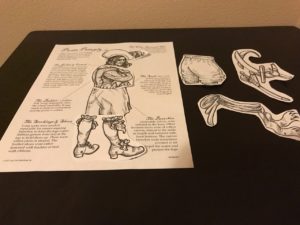 First up, the boys (the three older ones, ages 14, 11, and 5) have had a lot of fun playing the Pirate Panopoly game. This game comes with several pages, but really only two of them are necessary: the pirate and his clothes. The game is played like many other preschool level games, so was easy enough for my 5-year-old but still engaging for the older boys. Each player gets a printout of the pirate in his “skivvies” and one of his clothes. They can color the pictures if they want (mine didn’t – boys!) and then cut out the clothes. Once that’s done, each player sets his pieces in front of him. On his turn, he rolls a die and depending on the number shown puts a piece of clothing on his pirate. The first person to fully dress his pirate wins!
First up, the boys (the three older ones, ages 14, 11, and 5) have had a lot of fun playing the Pirate Panopoly game. This game comes with several pages, but really only two of them are necessary: the pirate and his clothes. The game is played like many other preschool level games, so was easy enough for my 5-year-old but still engaging for the older boys. Each player gets a printout of the pirate in his “skivvies” and one of his clothes. They can color the pictures if they want (mine didn’t – boys!) and then cut out the clothes. Once that’s done, each player sets his pieces in front of him. On his turn, he rolls a die and depending on the number shown puts a piece of clothing on his pirate. The first person to fully dress his pirate wins!
This was a fun activity because on top of being a game (who doesn’t love to play “instead of” doing school?), students learn about the clothes of yesteryear. On the pirate page, there are labels naming and describing each piece of clothing. And if your kids are extra curious, you could easily make this part of a bigger unit study. In fact, it’s originally part of the Time Travelers: New World Explorers unit from Home School in the Woods. Pirate Panopoly is available for $1.95.
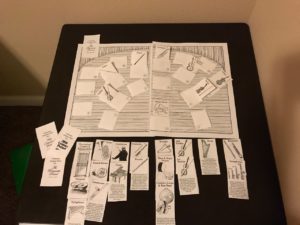 Next, we learned all about how orchestras have changed through the ages with The Orchestra file folder project. I chose this one for the boys because they dance ballet. I thought it would be good for them to learn more about the music they’re dancing to every week, and I was right.
Next, we learned all about how orchestras have changed through the ages with The Orchestra file folder project. I chose this one for the boys because they dance ballet. I thought it would be good for them to learn more about the music they’re dancing to every week, and I was right.
In this file folder project, you print out the images provided and glue the “stage” to your file folder. (We used an 11×17 sheet of paper because we didn’t have any file folders available.) Then you cut out the different pockets (each with a number that corresponds to a space on the stage) and glue or tape them into place. We were out of glue sticks when we did this project, so we used tape which proved to be a little tricky, but we managed in the end. Once that’s done, you cut out the different instruments and start studying the different time periods. For each time period, your student can slide the appropriate instruments into the pockets representing where the people who play that instrument would sit in an orchestra of the time period. It was really interesting for all of us to learn how those positions changed over time. The Orchestra is available for $4.95.
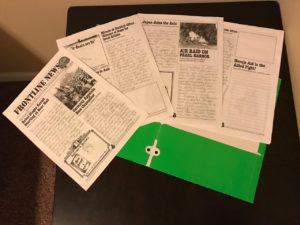 Finally, we received the Frontline News newspaper. This has been a really cool project for the older boys (they’re still working on it each school day). The PDF has 19 pages. The last 14 are what you need to print for your kids (really just 12 of the last 14; one of the pages is there twice and you print the one you want depending on whether you want the “classified ads” filled in or left blank for your student to complete). I printed ours double sided to make it feel more authentic.
Finally, we received the Frontline News newspaper. This has been a really cool project for the older boys (they’re still working on it each school day). The PDF has 19 pages. The last 14 are what you need to print for your kids (really just 12 of the last 14; one of the pages is there twice and you print the one you want depending on whether you want the “classified ads” filled in or left blank for your student to complete). I printed ours double sided to make it feel more authentic.
Each page has space for your student to write two articles, plus room for them to design an ad or two. Some of the articles come with photographs built in. Students are given a headline, which tells what they need to research, and then they fill in the rest, writing an article based on what they learned. For the most part, we were able to find the information using the large pile of books we got from the library, but there were also a few rather obscure stories that we ended up having to look online for. For example, did you know that the Navajo people used their language as a sort of “secret code” to help the Allies? That was something that didn’t show up in any of our books, not even the “Everything World War II” one.
You could move at whatever pace is good for your students when doing the newspaper project. Since this is now our main history for the time being (we’re not doing anything else or even supplementing this in any way), I’ve had the boys do one article and one ad per day. Between the research and the writing, that takes them a reasonable amount of time for the subject, without being too overwhelming. Frontline News is available for $2.95.
Overall, I’ve been really pleased with our choices, especially the newspaper. The boys agree that it’s a really fun way to learn about history, and we’ve decided together that we will very likely be purchasing more of these once they finish up Frontline News.
There are so many choices in the Á La Carte projects from Home School in the Woods that I can’t possibly mention them all here, but besides the categories of products I’ve reviewed, there are also Timelines (the Composers Through History timeline would go very nicely with The Orchestra file folder project), 3D projects (The Art of Quilling looks especially neat), Lapbooks, and more! I really hope you’ll check them out, especially if you need to breathe new life into your history studies. Each of the projects has its own recommended age level, but there are things from K all the way through 12th grade, so you’re guaranteed to find something that will work for your kids.
Members of the Homeschool Review Crew had their choice of anything from the Á La Carte “menu,” so make sure to click the banner below to find reviews on other projects!
Blessings,


Parenting Made Practical (review)
Being a parent is hard work. Anyone with kids – especially teenagers – can attest to that. It can be a very frustrating process to teach your kids to really listen to you and not just tune out as soon as you open your mouth to chastise/discipline them. Taming the Lecture Bug . . . and Getting Your Kids to Think by Joey and Carla Link is a book for parents of kids ages 8 and up to help teach you how to get your kids to actually start taking responsibility for their actions instead of constantly giving them the same lecture over and over again.
This book, offered by Parenting Made Practical, has 12 chapters for parents to work through. The opening chapter, Blah, Blah, Blah, takes the authors’ real life experiences with their children and showcases how they used to just lecture their children whenever they (the kids) didn’t do something. Sound familiar? It does to me. I’m sure there are a lot of parents out there who utilize this technique as a form of teaching discipline. But think back to your own teenage years; did you listen – really listen – when you were getting one of these lectures from your parents? Yeah, me neither. Teens and pre-teens think they’re so smart. Much smarter than their parents. This is why lecturing them doesn’t work.
The psychology of the child goes much deeper than that, though. Taming the Lecture Bug also has chapters on that, explaining not only why kids don’t think, but why to a certain extent it’s the parents’ fault they don’t. They break it down into six main reasons: reminders, lectures, anger, busyness, expectations, and being well-trained (the parents by the kids, not the other way round). By not teaching our children to manage their time well (and suffering the consequences when they don’t), we’re actually doing more harm than good for our kids. This was a bit of a hard pill for me to swallow, because I always want to help my kids and keep them out of trouble. But in the long run, I’m not helping by doing that. Reminding them of their chores and schoolwork is actually doing them harm (according to the authors of this book).
In order to “tame the lecture bug” in yourself, you have to open up a dialogue with your children. The key word there is dialogue – not monologue. Start retraining your children’s stubborn heart by teaching (or reminding) them about sin. We all need to be in a good place with God, and that means confessing our sins. As long as our children are being defiant to us, they’re also being defiant to God. Instead of lecturing (the monologue), ask them open-ended questions (Why did/didn’t you do that? What were you thinking when you did that? How do you think I felt when in,earned of your behavior? Did you think you’d get away with it?) to start a dialogue. Use their answers as a springboard to the sin conversation.
It’s not an easy path, but we all knew that when we decided to have kids. With the help of resources like this one, it can be a little easier though.
Members of the Homeschool Review Crew are discussing a variety of Parenting Made Practical resources this week. Click the banner below to learn more about
Why Can’t I Get My Kids to Behave?
Navigating the Rapids of Parenting
Dating, Courting, and Choosing a Mate… What Works?
What Every Child Should Know Along the Way
as well as a video version of Taming the Lecture Bug.
Blessings,


10 Years of Casey and Kyle
My husband’s comic strip (which has been largely supporting our family for nearly 10 years) celebrated its birthday last month. It’s hard to believe that the two kids who were the original inspiration are now 14 and 11!
To help commemorate the occasion, we had a party at the local library. The children’s librarians there have been immensely supportive of the comic for years (including letting us have the last book launch party there two years ago), so it was a natural choice. We had quite a few kids come to do Casey and Kyle themed crafts, and all of them really enjoyed it. It was super fun to see the kids excited about the characters and to hear them recite their favorite jokes (from the strip) to their parents. He even wrote a new book for the celebration (though it wasn’t quite back from the printers… we’ll actually see it the first week of April).
Our older boys were each in charge of one of the craft tables; the younger set got to participate by making crafts and otherwise just enjoying the party. Small Fry loved getting his picture taken with the life-size characters.
From its conception, Casey and Kyle has been a really fun ride, and we’re looking forward to (at least) 10 more years 🙂
Blessings,
(Re)Learning Cursive with CursiveLogic (review)
A few weeks ago, the opportunity to review the CursiveLogic Quick Start Pack was presented to me. I might have passed, but then I got to thinking about Seahawk and how he sometimes forgets how to form his cursive letters. And when he doesn’t forget, they’re often sloppy – not difficult to read per se, just messy. So after some careful consideration, I decided he could probably benefit from CursiveLogic. In addition to the main curriculum workbook, we also received a copy of the The Art of Cursive coloring book. The other benefit of doing this review at this time was that it was right around the time we were displaced due to flooding, and having a physical workbook was something of a calming influence. It’s hard to explain, but it really helped us to feel grounded in a frantic time in our lives.
CursiveLogic is a bit of a different approach to writing in cursive. It doesn’t just teach the letters. Instead, this method breaks each letter down by shape, helping students to figure out the very basics of writing in cursive. Students learn at a young age to draw circles, but they’re never (usually) really taught how to use that basic skill to influence their handwriting. Thinking about it after having used CursiveLogic with my son (age 14) for a few weeks, and it really makes a lot of sense now, though. CursiveLogic has broken it down into four basic “starting” shapes, and every single letter in the English alphabet falls into one of those categories. The main one I’ll focus on today is the “orange oval,” which includes the letters A, C, D, G, Q, and O (in lowercase).
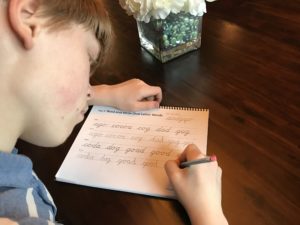 Lessons are grouped by the color shape of the different letters, so your student won’t be learning the letters in alphabetical order. Each lesson has several parts and is divided up into “days.” Depending on your student and his or her maturity and motivation, you could potentially move quite quickly through the lessons. We chose to move a bit slower (as written, not too slow), but that’s because I really wanted to monitor my son and make sure he was mastering each shape as we moved. He’s a typical teenager and tends to a) be more concerned about finishing than doing well and b) easily revert back to old habits. I really wanted him to focus and get those shapes down as muscle memory before we moved on, so we didn’t move as fast as we might otherwise have with a student who already knows how to read, print, and write in cursive.
Lessons are grouped by the color shape of the different letters, so your student won’t be learning the letters in alphabetical order. Each lesson has several parts and is divided up into “days.” Depending on your student and his or her maturity and motivation, you could potentially move quite quickly through the lessons. We chose to move a bit slower (as written, not too slow), but that’s because I really wanted to monitor my son and make sure he was mastering each shape as we moved. He’s a typical teenager and tends to a) be more concerned about finishing than doing well and b) easily revert back to old habits. I really wanted him to focus and get those shapes down as muscle memory before we moved on, so we didn’t move as fast as we might otherwise have with a student who already knows how to read, print, and write in cursive.
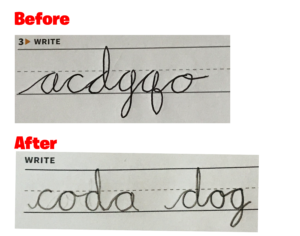 You can see in Seahawk’s “before” picture that his handwriting was adequate. Not amazing, not terrible, but adequate. After working on this lesson for just a few days, he showed great improvement. The thing that really helped him master it was when I explained to him that the oval shape has a bit of a hook on top before changing from the shape to the letter. Before this, he was getting more of a slide up into the letters rather than the oval shape. Once he understood the purpose of the oval, his handwriting improved immensely – and he said it was easier to write that way! It was quite rewarding to watch him “get it” and hear how much he appreciated these lessons. But it’s easier to appreciate something when you (the student) can see your own improvement, which was totally the case with Seahawk and CursiveLogic.
You can see in Seahawk’s “before” picture that his handwriting was adequate. Not amazing, not terrible, but adequate. After working on this lesson for just a few days, he showed great improvement. The thing that really helped him master it was when I explained to him that the oval shape has a bit of a hook on top before changing from the shape to the letter. Before this, he was getting more of a slide up into the letters rather than the oval shape. Once he understood the purpose of the oval, his handwriting improved immensely – and he said it was easier to write that way! It was quite rewarding to watch him “get it” and hear how much he appreciated these lessons. But it’s easier to appreciate something when you (the student) can see your own improvement, which was totally the case with Seahawk and CursiveLogic.
When he finishes the workbook, I think Seahawk will enjoy taking some colored pencils to the coloring book. We didn’t do a whole lot with it during the review period because I wanted him to focus on the actual work at hand (remember that teenager mentality – he could easily have tried to talk me into letting him color instead of doing a lesson, and that’s not adequate). In fact, The Art of Cursive is designed as a supplement to the curriculum, and is not intended to be something done instead of the lessons. He does seem quite interested in being able to work on the pictures that “are made up of cursive letters and words.” I think having that coloring book hanging out “mocking” him will be good motivation to him being willing to finish this curriculum.
In addition to the workbook and coloring book, CursiveLogic has a webinar. I wasn’t able to view it because we have iffy internet at the moment, what with being in temporary housing. Especially at the beginning of this review, I had no idea when we would be moving again. There are lots more Crew reviews, though, and several (maybe even most, I’m not sure) of them did watch the webinar, so make sure to click the banner below and check those out so you can learn more about that.
If you’re interested in trying CursiveLogic with your child (or yourself!), now is a great time to do it. CursiveLogic is offering a 20% discount on the CursiveLogic Quick Start Pack, which includes the workbook (not the coloring book) and webinar. These retail for $49 together. Just use coupon code CREW2018, which is good through March 31st, 2018.
Blessings,





